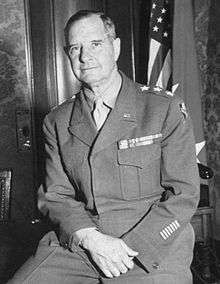Geoffrey Keyes
| Geoffrey Keyes | |
|---|---|
 | |
| Born |
October 30, 1888 Fort Bayard, New Mexico, United States |
| Died |
September 17, 1967 (aged 78) Walter Reed Hospital, Washington, D.C., United States |
| Buried at | West Point Cemetery |
| Allegiance |
|
| Service/branch |
|
| Years of service | 1913–1950 |
| Rank |
|
| Unit |
|
| Commands held |
9th Armored Division II Corps Seventh Army Third Army |
| Battles/wars |
Pancho Villa Expedition World War I World War II |
| Awards |
Army Distinguished Service Medal (3) Legion of Merit Silver Star (2) Bronze Star |
Lieutenant General Geoffrey Keyes (October 30, 1888 – September 17, 1967) was a highly decorated senior officer of the United States Army who commanded II Corps during the Italian Campaign of World War II.
Biography
Early life and Military career
Geoffrey T. Keyes was born on October 30, 1888 in Fort Bayard, New Mexico, the son of Captain Alexander S. B. Keyes, a United States Army officer, and his wife, Virginia Maxwell Keyes. Like his father, Geoffrey enrolled as a cadet at the United States Military Academy (USMA) at West Point, New York on March 2, 1908 and graduated on June 12, 1913, being commissioned as an officer, with the rank of second lieutenant, into the Cavalry Branch of the U.S. Army. His first assignment was with the 6th Cavalry Regiment, where he served until October 1916 and participated in the Pancho Villa Expedition.
His next assignment was at the USMA, where he served as an instructor of French language. He was also head football coach for one season in 1917, compiling a record of 7–1. During World War I he served in the United States as an instructor at the USMA.
Between the wars
His interwar service included duty with Panama Canal Division as an Assistant Chief of Staff (G-3), instructor at the USMA and the U.S. Army Cavalry School at Fort Riley, Kansas and Chief of Supply of Supply Division within War Department. He also graduated from the U.S. Army Command and General Staff School in 1926 and the U.S. Army War College in 1937.
World War II
In 1940, during World War II, he was chief of staff of the 2nd Armored Division, under Major General George S. Patton. From June to September 1942, he Commanding General (CG) of the 9th Armored Division before going to North Africa as Deputy CG of the I Armored Corps, commanded by Patton, which was later redesignated the U.S. Seventh Army for the Allied invasion of Sicily (codenamed Operation Husky).

He was originally serving as deputy commander of the Seventh Army during the campaign, once again serving under Patton. During Husky, when Patton split the Seventh Army in half, Keyes was given command of the Provisional Corps, which captured most of Western Sicily, including Palermo, the Sicilian capital, earning Keyes the Army Distinguished Service Medal.
In September 1943 he assumed command of the II Corps from Major General John P. Lucas and commanded it throughout the Italian Campaign, landing in Italy in November and serving under Lieutenant General Mark W. Clark's American Fifth Army. His first major battle was the Battle of San Pietro Infine and later, with Major General Fred L. Walker's 36th (Texas) Infantry Division under command, his corps took part in the controversial Battle of Rapido River, part of the first Battle of Monte Cassino. The corps was then involved in Operation Diadem, the fighting on the Gothic Line and the Spring 1945 offensive in Italy.
Postwar
After the war he commanded the Seventh Army from 1945 to 1946 and the Third Army from 1946 to 1947. In 1947, Keyes was appointed U.S. High Commissioner on the Allied Council for Austria. He served as Director, Weapons Systems Evaluation Group (WSEG) from 1951 to 1954.
Keyes retired from the army in 1954, after 41 years, and died on September 17, 1967 at Walter Reed Hospital in Washington, D.C..[1] He is interred at West Point, New York.
Decorations
Lieutenant general Keyes's ribbon bar:
Head coaching record
| Year | Team | Overall | Conference | Standing | Bowl/playoffs | ||||
|---|---|---|---|---|---|---|---|---|---|
| Army Cadets (Independent) (1917) | |||||||||
| 1917 | Army | 7–1 | |||||||
| Army: | 7–1 | ||||||||
| Total: | 7–1 | ||||||||
References
- ↑ AP (September 19, 1967). "GEOFFREY KEYES, COMBAT LEADER; Commanding General of 2d Corps in Italy Dies at 78". The New York Times. Retrieved August 10, 2011.
External links
| Wikimedia Commons has media related to Geoffrey Keyes. |
| Military offices | ||
|---|---|---|
| Preceded by New post |
Commanding General 9th Armored Division June 1942 – September 1942 |
Succeeded by John W. Leonard |
| Preceded by Omar Bradley |
Commanding General II Corps 1943–1945 |
Succeeded by Post deactivated |
| Preceded by Wade H. Haislip |
Commanding General Seventh Army 1945–1946 |
Succeeded by Oscar Griswold |
| Preceded by Lucian Truscott |
Commanding General Third Army 1946–1947 |
Succeeded by Ernest N. Harmon |